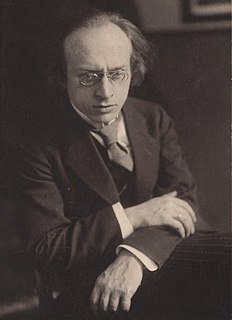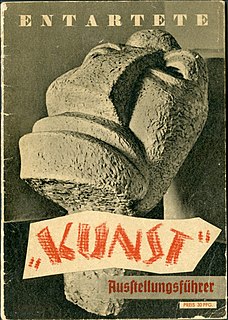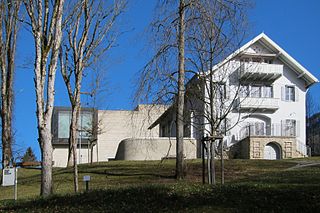
Dada or Dadaism was an art movement of the European avant-garde in the early 20th century, with early centres in Zürich, Switzerland, at the Cabaret Voltaire. New York Dada began c. 1915, and after 1920 Dada flourished in Paris. Dadaist activities lasted until c. the mid 1920s.

Degenerate art was a term adopted in the 1920s by the Nazi Party in Germany to describe modern art. During the dictatorship of Adolf Hitler, German modernist art, including many works of internationally renowned artists, was removed from state-owned museums and banned in Nazi Germany on the grounds that such art was an "insult to German feeling", un-German, Jewish, or Communist in nature. Those identified as degenerate artists were subjected to sanctions that included being dismissed from teaching positions, being forbidden to exhibit or to sell their art, and in some cases being forbidden to produce art.

In art history, Secession refers to an historic break between a group of avant-garde artists and the conservative European standard-bearers of academic and official art in the late 19th and early 20th century. The use of the term "secession" to describe young pioneers artistically migrating from the "old country" to create a new one was almost certainly inspired by the history of annexation, secession and dissolution in the city-states of Central Europe. Credited to Georg Hirth (1841–1916), the editor and publisher of the influential German art magazine Jugend (Youth), which inspired the Jugendstil, he used the term "secession" to emphasize the painful rejection of legacy art and the fits and starts of a splinter group forging a new "school" of art.

Natalia Sergeevna Goncharova was a Russian avant-garde artist, painter, costume designer, writer, illustrator, and set designer. Goncharova's lifelong partner was fellow Russian avant-garde artist Mikhail Larionov. She was a founding member of both the Jack of Diamonds (1909–1911), Moscow's first radical independent exhibiting group, the more radical Donkey's Tail (1912–1913), and with Larionov invented Rayonism (1912–1914). She was also a member of the German-based art movement Der Blaue Reiter. Born in Russia, she moved to Paris in 1921 and lived there until her death.

Sophie Henriette Gertrud Taeuber-Arp was a Swiss artist, painter, sculptor, textile designer, furniture and interior designer, architect, and dancer.

Paul Schultze-Naumburg was a German traditionalist architect, painter, publicist and author. A leading critic of modern architecture, he joined the NSDAP in 1930 and became an important advocate of Nazi architecture.

Leo von Klenze was a German neoclassicist architect, painter and writer. Court architect of Bavarian King Ludwig I, Leo von Klenze was one of the most prominent representatives of Greek revival style.

Herwarth Walden was a German Expressionist artist and art expert in many disciplines. He is broadly acknowledged as one of the most important discoverers and promoters of German avant-garde art in the early twentieth century. He was best known as the founder of the Expressionist magazine Der Sturm and its offshoots.

Modern Greek art is art from the period between the emergence of the new independent Greek state and the 20th century. As Mainland Greece was under Ottoman rule for all four centuries, it was not a part of the Renaissance and artistic movements that followed in Western Europe. However, Greek islands such as Crete, and the Ionian islands in particular were for large periods under Venetian or other European powers' rule and thus were able to better assimilate the radical artistic changes that were occurring in Europe during the 14th-18th century. The Cretan School and in particular the Heptanese School of art are two typical examples of artistic movements in Greece that followed parallel routes to Western Europe. As such, there were different artistic trends in the emerging Greek society. Modern Greek art can be said to have been predominantly shaped by the particular socioeconomic conditions of Greece, the large Greek diaspora across Europe, and the new Greek social elite, as well as external artistic influences, predominantly from Germany and France.
The Thannhauser Galleries were established by the Thannhauser family in early 20th century Europe. Their cutting-edge exhibitions helped forge the reputations of many of the most important Modernist artists.
Zen 49 was a group of German artists, who came together in the gallery "Otto Stangl" in Munich in July 1949. Originally the Gruppe der Ungegenständlichen, they took the name Zen 49 the following year. The seven members were Willi Baumeister, Rolf Cavael, Gerhard Fietz, Rupprecht Geiger, Willy Hempel, Brigitte Meier-Denninghoff and Fritz Winter. They were joined by Bernard Schultze in 1955.
The Marinko Sudac Collection, based in Zagreb, Croatia, has been created with a clear collecting strategy based on the region of Central and Eastern Europe, additionally spanning from the Baltic area to the Black Sea. The guiding principle of the Collection is systematic exploration, researching, and promotion of the avant-garde practices which have been marginalized, forbidden, and at times completely negated due to the historical, social and political circumstances. In this context, the Marinko Sudac Collection gives the most complete and comprehensive overview on the art of this region. The Collection starts at 1909, and it show the continuity from the first Avant-Gardes, through neo-avant-garde and New Artistic Practices, ending with the fall of the Berlin Wall. The global uniqueness of the Marinko Sudac Collection is also seen in the kind of media it contains. It contains not only traditional artworks, such as paintings, sculptures, and photographs, but it gives equal importance to documentary and archival material. Great importance is put on these almost forgotten media, which enable research of specific phenomena, artists and the socio-political situation which affected this type of art. The Collection contains a great number of museological units, and it treats the documentary and archival material on the same level as traditional artworks. By examining the units contained in the Marinko Sudac Collection, one can read not only the art scene or the art production of a certain artist, but the full status of the society, the socio-political atmosphere of the region in which this art was created in.
The following is a timeline of the history of the city of Munich, Germany.

The Degenerate Art Exhibition was an art exhibition organized by Adolf Ziegler and the Nazi Party in Munich from 19 July to 30 November 1937. The exhibition presented 650 works of art, confiscated from German museums, and was staged in counterpoint to the concurrent Great German Art Exhibition. The day before the exhibition started, Hitler delivered a speech declaring "merciless war" on cultural disintegration, attacking "chatterboxes, dilettantes and art swindlers". Degenerate art was defined as works that "insult German feeling, or destroy or confuse natural form or simply reveal an absence of adequate manual and artistic skill". One million people attended the exhibition in its first six weeks. A U.S. critic commented "there are probably plenty of people—art lovers—in Boston, who will side with Hitler in this particular purge".
Tenmyouya Hisashi is a Japanese contemporary artist.
Justin K. Thannhauser (1892–1976) was a German art dealer and an important figure in the development and dissemination of Modern art in Europe.
Galerie nächst St. Stephan is an art gallery in Vienna, Austria that was founded by Monseigneur Otto Mauer in 1954 on Grünangergasse next to the Stephansdom, where it is still located today. Rosemarie Schwarzwälder has owned the gallery since 1987. Before that, she was the gallery’s director since 1978. Schwarzwälder has made the gallery the international renowned institution that it is today.

Annot, also known after her marriage as Annot Jacobi, was a German painter, art teacher, art writer and pacifist. As a result of political hostility in Germany, she spent much of her life in the United States and Puerto Rico.

The Martiusstraße in Munich Schwabing leads from Leopoldstraße to Kißkaltplatz. It was named after naturalist Carl Friedrich Philipp von Martius. He was director of the Alter Botanischer Garten in Munich and member of the Bavarian Academy of Sciences and Humanities.

The Franz Marc Museum is a museum located in Kochel am See, Upper Bavaria, dedicated to German Expressionist painter Franz Marc. The museum shows paintings by Franz Marc, and also works of art of his contemporaries and other important artists of the 20th century, in a permanent and in temporary exhibitions.












